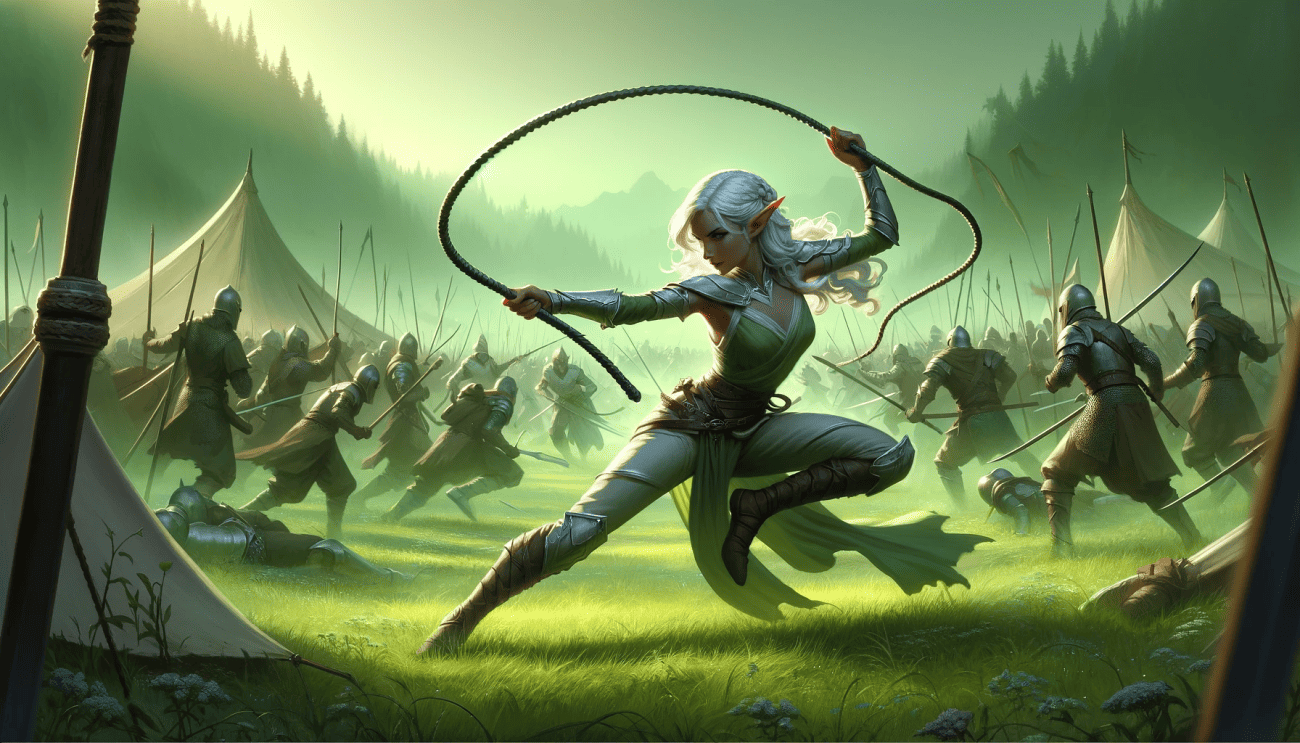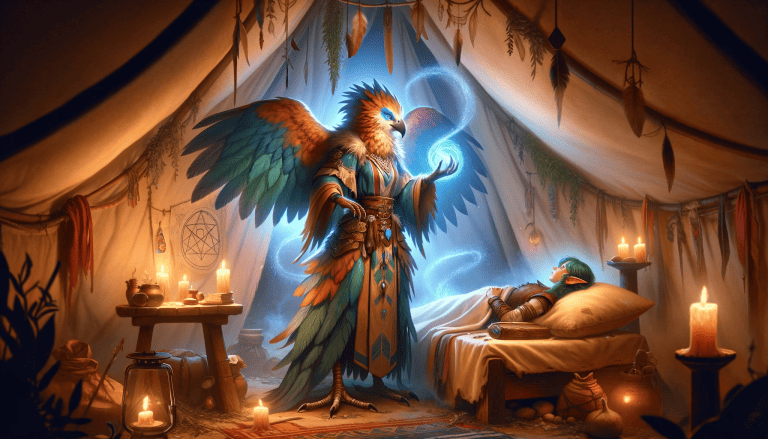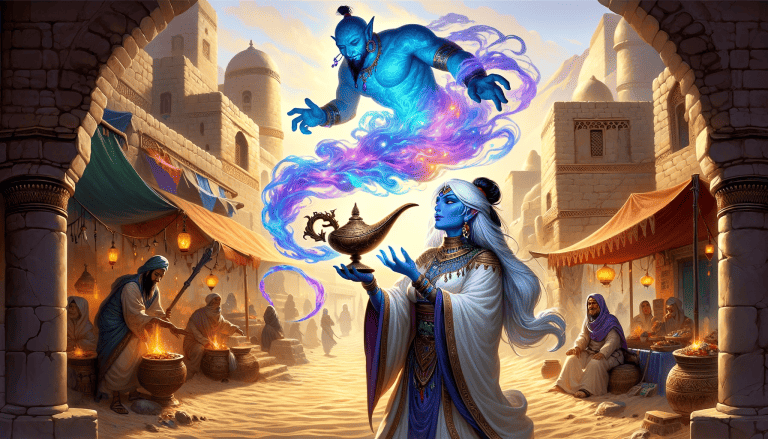A Beginner’s Guide to Monk Subclasses in 5e D&D
All Monks are different, especially as they reach level three, where you choose which Monk archetype or monastic tradition you fancy. There are ten main Monk subclasses, and I’m going to give you a run-down on every single one. Whether you fancy ‘traditional’ style Monks like the Way of the Open Hand or Doctor Death himself, the Way of the Long Death (sounds painful, right?) I’ll give you the yays and nays of them all.
We’re here to steer you on your journey and make that all-important decision of which Monk monastic tradition fits your character vision. This is a guide, after all. So let us guide you.
Using This Guide
Everything in this Monk subclass guide has an emoji, ranking how useful a given ability or feature is within the Monk character build.
✅ Perfect subclass or top-class feature. Delivers the foundation of the subclass build. The more of these the better the subclass.
🆗 Solid and great. It will certainly help but you can live without it for the build. A strong monastic tradition.
⚠️ Debatable. An okay subclass. Features might work for some specific builds but could be a wasted skill or not as powerful as other features.
⛔ No. Bad feature or subclass choice and could damage the build. Especially as you level.
This emoji guide is just a guide. You can build your Monk character however you like, and sometimes, a not-so-great feature can add flavor and layers to your character build.
🧘 Read our in-depth Monk subclass guides:
- Way of the Astral Self
- Way of the Cobalt Soul
- Way of the Sun Soul
- Way of the Shadow
- Way of the Kensei
- Way of the Open Hand
🆗 Way of the Astral Self – Tasha’s Cauldron of Everything
If you imagine a ghost ninja, then you’re pretty much spot on with this Monk subclass. The true spirit Ki form of the Monk slowly emerges as you level up till you go full ghost ninja on your unsuspecting foe. Like Casper, the friendly ghost with less friendly and more punching.
As you level up as a Monk, you become one with your Ki and more of your astral body appears. This gives you offensive, defensive, and utility-style options.
Your Wisdom modifier is quite important with the Way of the Astral Monk subclass, as it replaces some of your Strength and Dexterity checks.
✅ Arms of the Astral Self
At level three, you get ninja ghost arms. Extremely handy, excuse the pun. Spend a Ki, and your astral arms appear. When you do this, each foe of your choice within 10ft needs to succeed on a Dex roll or take force damage. A definitively great feature of this subclass, making unarmed combat even better for your Monk character.
Not only that, but the whole floaty arms business lasts 10 minutes, hovering near your shoulders or over your arms. Think General Grievous without the Lightsabers from Star Wars.
If you get incapacitated or die, they leave.
While these astral arms are hanging around, you get the following benefits
- You can use your Wisdom modifier for Strength checks or saves instead of your Strength modifier. Remember, Wisdom is a key ability score for a Monk. Take note.
- You can use your newly gained ghost arms to make unarmed strikes up to 5ft.
- You also use your Wisdom modifier instead of Strength or Dexterity for the attack and damage rolls.
Visage of the Astral Self
Landing at the 6th level, you get Visage of the Astral Self. Spend a Ki point, and what is essentially a spirit mask appears. You can either use it separately or in the same bonus action with Arms of the Astral Self. This mask lasts for 10 minutes and disappears if you’re incapacitated or die.
You gain the following benefits:
✅ Astral Sight
Darkvison! Yes! This is the Bee’s knees, especially if your race doesn’t get darkvision. Works in both magical and non-magical darkness. Up to 120ft!
🆗 Wisdom of the Spirit
Advantage on Insight and Intimidation rolls. Situational to say the least, but allows the Monk to possibly get crucial information in your campaign.
⚠️ Word of the Spirit
A variation on the good old Message Cantrip. You’re able to direct your words to a creature in your field of vision that’s up to 60ft away. Or alternatively, you can shout like a badass so everyone within a 600ft range can hear your incoherent ramblings. Situational.
Astral Sight is a top feature for those without Darkvision.
Body of the Astral Self
Once you’ve got floaty ghost arms and a floaty ghost mask, you get the floaty body bit at the 11th level. This apparition appears around you like a suit of ghost armor and comes with not one but two benefits—one for defense and the other for offense.
🆗 Deflect Energy
If any foe flings acid, cold, fire, force, lightning, or thunder damage at you and it hits, you can use a reaction to deflect it. This reduces the damage by 1d10 plus your Wis mod. Reduction enabled!
✅ Empowered Arms
Extra damage with floaty ghost arms. On every combat turn, when you hit a target with your Arms of the Astral Self, you get to deal extra damage equal to your martial arts die.
Personally, we found the Empowered Arms more useful since Deflect Energy is only used for specific attacks.
Awakened Astral Self
At the 17th level, your spiritual connection to your astral self is complete. Using 5, yes, 5 Ki points to unleash the astral self full potential, including floaty arms, head, and body, for a full 10 minutes. Ends when you die, etc.
While your astral self is awakened, you receive the following features:
✅ Armor of the Spirit
A spectacular +2 to your AC.
✅ Astral Barrage
If using your floaty arms to attack, you get to attack three times instead of two.
Two exceptional features here. If you add Flurry of Blows to the mix, you get five attacks with Astral Barrage. Whack, whack, thump, kick, and slap!
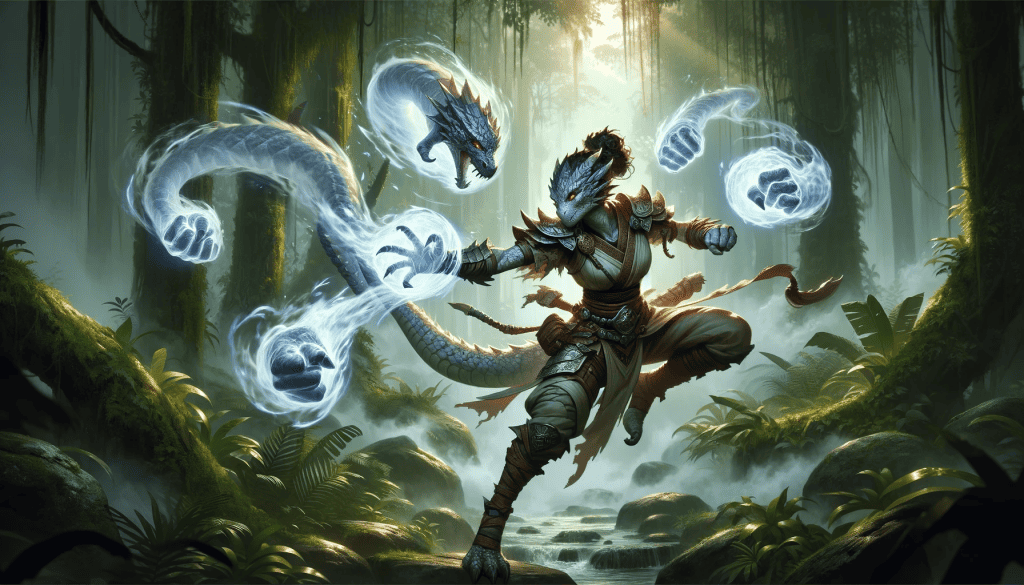
Snapshot of Astral Self
The Good Bits
Lots of excellent features and bonuses here for your spiritual self to use. However, the really good ones don’t happen till higher levels. Those floaty ghost arms are very handy.
The Bad Bits
It’s not really bad, but if your Monk is fancying the Way of the Astral Self, you’ve got to have a decent Wisdom Mod to get the full bonuses. Word of the Spirit is a bit underwhelming.
🆗 Way of the Drunken Master – Xanathar’s Guide to Everything
Unfortunately, the way of the Drunken Master subclass isn’t about getting your character loaded and going on a drunken rampage. But don’t let us stop you. If you want to have your character do that for flavor, it’s entirely up to you.
What Drunken master is is a fighting style and features of someone that is drunk—erratic twists and turns. Think Court Jester with fists.
⚠️ Bonus Proficiencies
At level 3, you gain proficiency in the performance skill. If you don’t already have it, of course. And brewer’s supplies. To be honest, both are very situational and not at all useful.
🆗 Drunken Technique
Also at the 3rd level, you gain the ability to combine disengage with Flurry of Blows using just one Ki point. Your walking speed also increases by 10ft. If your Monk is low on Hit Points but still needs to do damage, you can use this technique to run in, punch something, and run out again.
A really useful skill. The Monk in my party does this often, mainly because she doesn’t like getting hit! And is a bit of a chicken.
Tipsy Sway
When your Monk character reaches the 6th level, you gain the ability Tipsy Sway. Swagger to the left, sway to the right, just like a drunkard. Both features are a little underwhelming.
⚠️ Leap to your Feet
Gain the ability to only spend 5ft of movement instead of half movement when your character is prone. It’s a situational feature, to say the least.
🆗 Redirect Attack
If a foe misses you with an attack, you can spend a Ki point and redirect the hit to another foe. But only if they’re within 5ft of you. Good if you’re fighting multiple enemies. It’s ok, but I feel a little tweaking and this could be a much better feature.
⚠️ Drunkard’s Luck
At level 11, when you make a roll at disadvantage, whether it be an attack, ability check, or saving throw, you can spend two Ki to cancel out the roll. A little underpowered, and 2 Ki points? However, we all know having disadvantage on saves can be a life or death situation. So, I wouldn’t fully rule this out.
✅ Intoxicated Frenzy
At the 17th level, you can get Intoxicated Frenzy and run circles around your enemies. And add a further three attacks to your Flurry of Blows ability. Up to five attacks altogether. I love this feature, as you can really give a pummelling to a bunch of creatures in one turn. Well worth leveling up your Monk to get this feature.
Snapshot of Drunken Master
The Good Bits
Drunken technique, Redirect and Intoxicated Frenzy are this subclass’ star features. Really good offensive abilities.
The Bad Bits
It’s such a shame that the other features are a little underwhelming. They’re not terrible. They just don’t get me excited.
🆗 Way of the Cobalt Soul – DnD Beyond
Study your foe’s weaknesses and then use that knowledge to inflict pain and manipulate them. That’s the premise of the Way of the Cobalt Soul Monk subclass. Created by Matt Mercer of Critical Role fame and used by Marisha Ray with her Monk build Beauregard Lionett. There are some interesting features and bonuses here.
✅ Extract Aspects
At the 3rd level, your Monk can hit the pressure points on your enemy to extract information and use it against them. When you successfully hit a creature with a Flurry of Blows attack, you mark them as analyzed. When said creature misses you with their attack, you can use your reaction to make an unarmed attack back at them. And it lasts until a short or long rest.
It’s an excellent bonus, and getting it at 3rd level rather than later really gives a fantastic boost early on in your Monk-leveling.
As a bonus, you learn the following about your foe: Damage Vulnerabilities, Damage Resistances, Damage Immunities, and Condition Immunities.
⚠️Mystical Erudition
When you reach level six, your Monk’s brain allows you to learn another language. Plus, you gain proficiency in either Arcana, History, Investigation, Nature, or Religion. If you already have proficiency in any of those skills, you can double down on it. You get to do the same at levels 11 and 17.
The real problem with this feature is that it requires a decent Intelligence ability score. And if you check our DnD Monk guide, we say to use Int as a dump stat. So could be a problem here if your Monk’s Int is that of a rat brain.
🆗 Extort Truth
Also, at level six, you can punch your foe into not lying. Succeed on an unarmed attack and force them to roll a Charisma save. On a fail, you force your foe to tell the truth. Additionally, all Charisma checks made against the foe are made with advantage for up to 10 minutes.
This is great if you’re extracting vital information for your quest or campaign.
⚠️ Mind of Mercury
Arriving at level 11, you can spend a Ki point on every turn and take an additional reaction. A bit situational, and quickly throws those Ki points away. A bit of a flat skill.
🆗 Debilitating Barrage
When you hit with Flurry of Blows, strike pressure points, and spend 3 Ki points, you can make your enemy vulnerable to a damage type of your choice for a whole 1 minute.
Unless you’re in a situation where you’re fighting on your own (where you would choose bludgeoning damage), have a think about who in your party does the most damage with their spells or weapons. Whether it’s your fire damage leaning wizard, pierce damage swashbuckler, or psychic damage-orientated Bard. You get the picture.
Snapshot of Cobalt Soul
The Good Bits
Some really nice and useful features make this a fairly decent Monk monastic tradition.
The Bad Bits
Mystical Erudition, with its intelligence-based feature, is a throwaway.
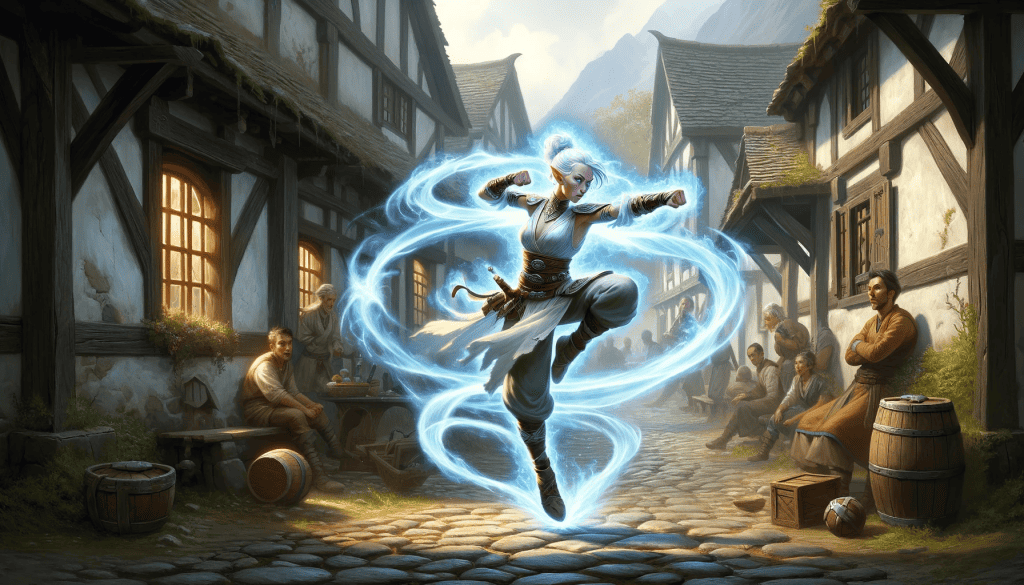
🆗 Way of the Four Elements – Player’s Handbook
Using the power of the four elements, your Monk can harness air, earth, fire, or water abilities at will. You can focus on one particular element or weave a few different ones together. This subclass effectively makes your Monk into a bit of a punchy spellcaster. Punch, fire!
Disciple of the Elements
At the 3rd level, you learn magical disciplines that draw the power of air, earth, fire, or water. Spend Ki points every time you use an elemental discipline.
You get the Elemental Attunement discipline and another elemental discipline of your choice. At levels 6, 11, and 17, you gain one additional elemental discipline.
🆗 Elemental Attunement
You get Elemental Attunement at level 3, which allows you to do one of the following things up to 30 feet away:
- Conjur is a non-damaging elemental effect related to one of the four elements. Something like a puff of wind, a small movement of earth, a spark, or a splash of water. Basically, something that’s connected to air, earth, fire, or water that doesn’t do damage.
- In an instant, you can light or snuff out a candle, torch, or small campfire.
- Warm up or cool down up to one pound of nonliving material for one hour.
- Shape mist, earth, fire, or water into a rough form that fits in a 1-foot cube.
This is a bit of a roleplaying and flavor ability—a bit of character fun you could say. It’s not entirely useful, but for layers of roleplay, it’s a good ability. And it’s not the crux of the build. If this was all you got at level 3 of the subclass, there would be DnD boos and hisses.
Elemental Disciplines
You get four of these as you go up in levels. One at 3rd, 6th, 11th, and 17th. They work similarly to spellcasting, except you use Ki points to cast and don’t need the materials. As you level up, you can use more Ki points to cast each Elemental Discipline at a higher level. A bit like a spellcaster, but instead of spell slots, you use more Ki.
Every time you gain a new Elemental Discipline you can swap another out for something different. Handy if it’s not working for you.
Also, you can only use a certain amount of Ki points per Elemental Discipline, depending on what Monk level you’re at. See the table below.
Spells and Ki Points
| Monk Levels | Maximum Ki Points for a Spell |
| 5th-8th | 3 |
| 9th-12th | 4 |
| 13th-16th | 5 |
| 17th-20th | 6 |
Ok, let’s dive in with the disciplines.
3rd Level Choices
Plenty of good choices here, with a few to avoid.
🆗 Fangs of the Fire Snake
Spend a Ki point on your attack, and flames reach out from your fists or up to 10ft away and do fire damage. When it hits, spend an extra Ki, and you get an extra 1d10 damage. Whoosh! Great if you need fire damage, but you can quickly use up those Ki points.
⚠️ Fist of the Four Thunders
Spend two Ki points and cast Thunderwave. Good damage scaling, but the AOE is small.
✅ Fist of Unbroken Air
As an action, spend 2 Ki points and wind punch, yes, wind punch an enemy up to 30-feet away. They have to make a Strength save, and on a fail, they take a huge 3d10 bludgeoning damage plus a 1d10 bludgeoning damage for every extra Ki point you spend. This is better, with lots of damage at a low level, plus it’s got a decent range.
⛔ Rush of the Gale Spirits
This is basically the Gust of Wind spell. You cast a 10ft wide gust of wind up to 60ft, pushing your enemy back 15ft. Honestly, it costs 2 Ki and is a bit trash. Leave it. There are better choices.
🆗 Shape of the Flowing River
This works similarly to the Shape Water spell. Turn water into ice, and vice versa, up to 120ft. It’s great discipline as long as there’s water or ice about.
✅ Sweeping Cinder Strike
Burning hands! Yep, this is that spell. 2 Ki points and flamey hands happen. A decent AOE with fine damage and good scaling.
✅ Water Whip
Spend a Ki, create a whip of water, and knock your foe prone or pull them towards you for some punching time. Also, does 3d10 damage on a failed Dex Save plus 1d10 per Ki point spent.
6th Level Choices
Only two at level six, both pretty decent:
✅ Clench of the North
This is the Hold Person spell. I like Hold Person, I like it a lot. It saved my ass a lot of times. So, I’m gonna give this discipline a big tick. It does cost 3 Ki to cast.
🆗 Gong of the Summit
This is basically the Shatter spell. Up to 60ft, you can create a gong of unbearable noise in a 10ft radius sphere. It does 3d8 damage if your target fails their Con save. Costs 4 Ki points.
All in all, Gong of the Summit is a little Ki pricy and works on Con saves, which can be high. Great AOE, though. If you get a decent amount of creatures in the AOE, it’s well worth the Ki spend.
11th Level Choices
Plenty of strong, solid choices here. In fact, I think you’ll struggle to choose which one to go for!
✅ Flames of the Phoenix
Fireball! Yes, this is where we are. You can punch and cast Fireball. You’ve finally arrived at the perfect combo. Seriously though, we all love the Fireball spell, and giving it to a punchy support character is a gift. A long range of 150 ft, 20ft-radius AOE, and that sweet 8d6 damage. Boom! Costs 4 Ki. Well worth it.
🆗 Mist Stance
Based on the spell Gaseous Form, except you’re targeting yourself. Costs 4 Ki points. Lasts for an hour. You can fly at a speed of 10ft, and are able to squeeze through gaps, cracks, and small spaces.
Great for sneaking and escaping. You have resistance to non-magical damage, plus you get an advantage on Strength, Dexterity, and Constitution saving throws. I really like this spell. My Ranger had it cast on him to infiltrate an underground lair and it was extremely useful when sneaking about.

✅ Ride the Wind
The Fly spell. Gain a flying speed of up to 60ft for up to 10 minutes for 4 Ki. The Monk in my party, Tan, had fly cast on her while we were having an arena fight. Watching her zip around the arena punching enemies was a joy. Great discipline.
17th Level Choices
Again, lots of solid options here. You’ll be spoilt for choice.
🆗 Breath of Winter
Cone of Cold spell for 6 Ki points. Blasting a 60-foot cone from your Monk’s fingertips. All creatures in the AOE need to do a Constitution saving throw. A fail gets 8d8 damage. Freeze, sucker! Great choice, but the AOE isn’t as good as Fireball and costs more Ki.
🆗 Eternal Mountain Defense
Spend 5 Ki to cast Stoneskin on yourself for one hour. You get resistance to non-magical bludgeoning, piercing, and slashing damage. A defense option for squishy Monk builds. Would like to have seen them add a little bit of AC.
🆗 River of Hungry Flame
Costing 5 Ki, this is the Wall of Fire Spell. You can make a wall up to 60 feet long, 20 feet high, and 1 foot thick. Or make it into a ring of fire with a 20ft radius. Creatures need to make a Dex save or get toasted with 5d8 damage.
✅ Wave of Rolling Earth
Spend 6 Ki for this discipline, which is basically Wall of Stone. Create a wall up to 120ft long, 10ft by 10ft, and 6 inches thick. AC 15 and 30 hit points per inch of thickness. With a concentration of up to 10 mins, it’s a fantastic defensive discipline that can turn the tide in battle for the whole party.
Snapshot of the Four Elements
The Good Bits
Well, there is a lot of information to digest here. If you like the idea of playing a Monk with spell elements without multiclassing, this subclass is definitely for you. There are some great Elemental Discipline combos there, allowing you to build a really interesting Monk character.
The Bad Bits
The Ki point cost can be a bit much, and the Ki scale quite quickly. Needing a short rest to get those ever-important Ki points back is a pain. Being able to use the Ki-Fueled Attack Optional Class feature will make a massive difference. Check with your DM first.
⚠️ Way of the Kensei – Xanathar’s Guide to Everything
The Way of the Kensei subclass delivers a Monk that predominantly uses weapons as an extension of their arms. A DnD Monk subclass is perfect for those who can’t let go of fighting with a sword or bow. And you can still punch, so don’t worry there.
Path of the Kensei
Starting at the 3rd level, you get Path of the Kensei, which has several features and bonuses. Some good and some questionable.
⚠️ Kensei Weapons
You get to choose two weapons for your initial Kensei Weapons at level 3. You gain proficiency with any simple or any martial weapons, one being melee and the other ranged. You can’t have any with heavy or special properties.
The problem with this is the optional Dedicated Weapon feature that all Monk builds can get now. You can touch a weapon and be proficient in it until you use the feature again. This makes the Kensei Weapons a bit redundant. The only saving grace is that you can stay proficient in the weapons you choose. A bit of a poor show, to be honest.
✅ Agile Parry
Making up for the poor Kensei weapons is this great feature! Thank you, DnD world. Ok, so with this lovely nugget, you get a +2 to AC. And the rule is this: If you make an unarmed hit as part of your attack action AND are holding a Kensei Weapon AND it’s a melee weapon, then you get the armor class bonus. Phew! With this subclass you’ll be doing all of those things in most situations, anyway. Punch and parry away!
🆗 Kensei’s Shot
When you make a ranged attack, you can use your bonus action to add 1d4 extra damage to the target. Doesn’t cost any Ki and is multiplied on a critical hit.
It would have been a big green tick if the damage was 1d6 or scaled on levels.
⚠️ Way of the Brush
Choose calligrapher’s supplies or painter’s supplies to gain proficiency. Utterly useless. Very rare you will use either of these. However, it feels like a flavorful extra than an actual feature.
One with the Blade
When you land on level six, you can use your powerful Ki on the following benefits:
✅ Magic Kensei Weapons
Your Kensei Weapons are classed as magical weapons. This is excellent as you don’t need to buy or search for that +1 sword for creatures that are immune to non-magical damage.
🆗 Deft Strike
Extra damage is available if you spend a Ki point on a successful hit with your Kensei Weapon. Spending a Ki on Flurry of Blows might work out better. Depends on the weapon.
⚠️ Sharpen the Blade
This feature is offered at level 11. As a bonus action, you can spend up to 3 Ki points and add them to the attack and damage rolls of that weapon. For example, spend 3 points on your spear, and it effectively becomes a Spear +3. Lasts for one minute or until you use it on another weapon. Flurry of blows is probably a better way to spend that amount of Ki. Disappointing.
🆗 Unerring Accuracy
At level 17, you’ve become one with your Monk weapon and can reroll a missed attack once per turn.
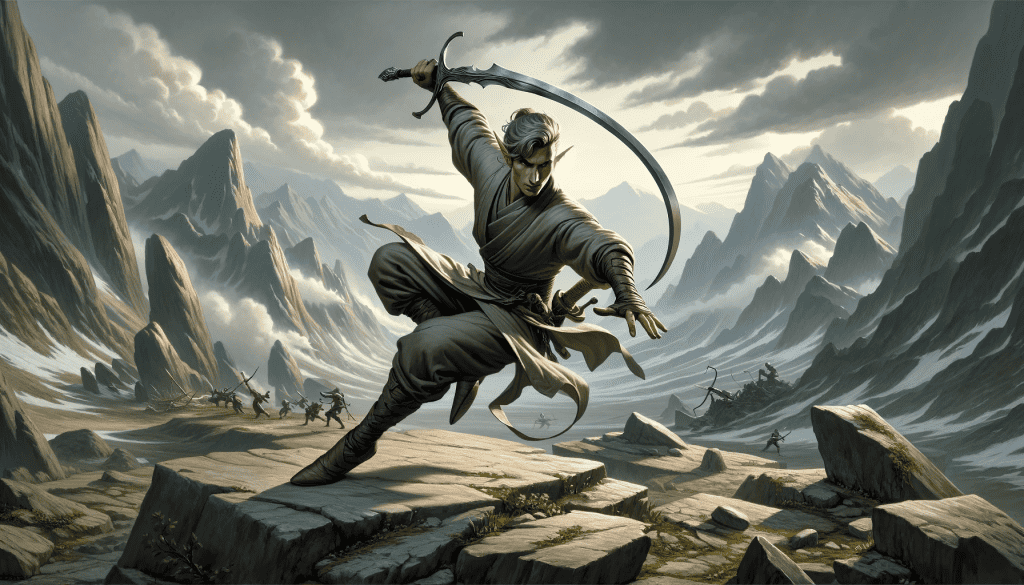
Snapshot of the Kensei
The Good Bits
It’s a bit of an unmixed balance with the Kensei subclass. There are a lot of good features. Kensei’s Shot, Agile Parry, Deft Strike, and Unerring Accuracy are all great.
The Bad Bits
Having that optional feature dedicated to Monk weapons throws a spanner in the works, and Sharpen the Blade is disappointing. I think with a clever thought-out build, this Monk subclass might work.
✅ Way of the Long Death – Sword Coast Adventurer’s Guide
This Monk subclass has an unhealthy obsession with death. Utilizing the Way of Death, you get features and bonuses all focusing around death. Did I mention death? You only get four features in this Monk subclass, but boy are they all pretty good. It’s a strong subclass, but not for the faint-hearted.
✅ Touch of Death
You start this monastic tradition at level 3 with the Touch of Death feature. When you reduce a creature within 5ft to 0 hit points, you get some of those temporary hit points equal to your Wisdom Modifier plus your Monk level. Extremely handy in battle as your foes fall around you. Or, if you’re feeling a little peaky, drop into the forest and knock a few squirrels out. We won’t tell.
✅ Hour of Reaping
As your weird obsession with death increases at level 6, you get to scare the crap out of the local thieves guild. As an action, each foe within 30 feet of you needs to make a successful Wisdom save or be frightened of you until your next turn. This works really well when a bunch of enemies surrounds you.
🆗 Mastery of Death
Landing at level 11, if you get reduced to 0 hit points, you can spend a Ki point to escape death’s deadly clutch and receive 1 hit point. I would like to have seen a few more hit points for your 1 Ki point. But either way, this feature is top-class.
🆗 Touch of the Long Death
As an action at your 17th level, you can spend between 1 to 10 Ki points and channel your death ray into a creature up to 5 feet away. They must make a Constitution save, and on a fail, they take 1d10 per Ki point spent. Plus, half damage on a save.
It takes a lot of Ki to do a decent amount of damage, but it’s still a great feature. Also, Con saves are common amongst creatures, so they could be saved easily.
Snapshot of the Long Death
The Good Bits
Lots, all the features are great, not one bad egg. A really good Monk build can be made from this subclass.
The Bad Bits
There are not enough features, and I would like to see just a few little extras for flavor. You get to wear a hooded cloak or proficiency in scythe or a skull mask. You get the picture.
✅ Way of the Mercy – Tasha’s Cauldron of Everything
The choice between who lives and who dies is the decision left with the Way of Mercy Monk. Like a plague doctor of old, this Monk subclass dances the weave between life and death, making informed decisions on which of you is allowed to carry on with life, and which of you must see the reaper.
🆗 Implements of Mercy
Well, what do we get here? At 3rd level, you get a mask rolled on the Merciful Mask table or simply choose your own. I like this, even if it is just flavor. It’s just a nice way to mold your character build.
You gain proficiency in Insight and Medicine skills, plus proficiency in the herbalism kit. Insight is great and a skill that is utilized a lot in DnD. Medicine is okay. Nothing majorly special. With the herbalism kit, you can make healing potions. Excellent!
🆗 Hands of Healing
Also, at the 3rd level, you get this nice healing bonus feature. As an action, you channel your magical energy and touch a creature, healing them for a roll of your Martial Arts die + your Wisdom modifier. Costs 1 Ki point. You can also replace an unarmed strike in Flurry of Blows with this feature to avoid spending a Ki point. Good for a backup healer and if you have a decent Wis mod.
🆗 Hands of Harm
Quite the opposite of Hands of Healing. Once per turn, when you strike a foe with an unarmed punch, you can use a Ki point to do Martial Arts die + your Wisdom modifier extra damage. Again, this works great if you have a high Wisdom mod.
✅ Physician’s Touch
At level 6, when you use Hands of Healing, you can also remove one of the following afflictions: blinded, deafened, paralyzed, poisoned, or stunned. Pretty good, right?
Or
If you’re feeling a little evil and use Hands of Harm, you can poison your target until the end of your turn. Two great features here, and I love the extension of each of the level 3 abilities.
✅ Flurry of Healing and Harm
When you use Flurry of Blows at the 11th level, you can replace each of the Unarmed Strikes with Hands of Healing. No Ki points need to be spent.
On the opposite side, you can also replace one of the blows from Flurry of Blows with Hands of Harm without spending Ki. Only once per turn. So effectively, you could heal and harm or heal and heal. Again, no Ki needs to be spent! A great feature when you’re deep in the fight and simultaneously kick a foe’s ass and heal a party member in the same turn.
✅ Hand of Ultimate Mercy
Ok, this is a gift. At the 17th level, if a party member, friend, or even Damric, the local Dwarven Barkeep, dies, you’ve got 24 hours to spend 5 Ki and bring them back to life with a simple touch. They gain hit points equal to 4d10 + your Wisdom modifier, and any condition, such as blinded, deafened, paralyzed, poisoned, or stunned, are removed. Essentially, you can even have a short rest and regain Ki before you do this. A fantastic feature of an excellently formed Monk subclass.
Snapshot of the Mercy
The Good Bits
All of it. An extremely well-balanced subclass with some perfectly balanced features and even a bit of flavor for RP.
The Bad Bits
Nope. None.

🆗 Way of the Open Hand – Player’s Handbook
If you’re dead set on playing a traditional style Monk where unarmed martial arts is your thing, then the Way of the Open Hand Monk is the one for you.
I played one purely because I wanted to play a streetfighter without having to use a homebrew brawler. He was good and fun to play and non-traditional. So that’s an example of using the Open Hand without going down the traditional route.
✅ Open Hand Technique
Right at 3rd level, you can do an extra effect when you hit a foe with one of your Flurry of Blows. Because you typically dump strength as a Monk, being able to knock over or knock away an enemy is pretty top-class. And none of these cost any extra Ki points.
- It must succeed on a Dexterity saving throw or be knocked prone.
- It must make a Strength saving throw. If it fails, you can push it up to 15 feet away.
- It can’t take reactions until the end of your next turn.
🆗 Wholeness of Body
At level 6, you can channel that Monk energy and heal yourself. Gain three times your Monk level worth of hit points. No Ki needs to be spent. A little redundant, thanks to the optional Quickened Healing Monk feature. But still cool. Long rest after use.
⚠️ Tranquility
Arriving at level 11, you gain the effect of the Sanctuary spell, which lasts until the start of a long rest (or earlier, if you like). The saving throw DC for the spell equals 8 + your Wisdom modifier + your proficiency bonus. It’s alright, but you’ll probably use it on your first fight and then forget about it till you have your long rest.
✅ Quivering Palm
This feature of the Way of the Open Hand is absolutely top-class. At the 17th level, you get to tap into your enemy’s weaknesses. If you make a successful unarmed strike, you set off vibrations in your foe’s body which last days. They are harmless until you decide to end them. When you do, the target must make a Constitution save. If they fail, their hit points are reduced to 0, and they fall down. If they save, they take 10d10 necrotic damage, which could also make them fall down. A well-balanced feature.
Snapshot of Open Hand
The Good Bits
Most of this ‘pure’ Monk class is fantastic. It builds further on the Monk build, extending the standard features you get with the Monk class.
The Bad Bits
That dam tranquility is just a little bit of a letdown. Personally, I would like more punching and kicking bonuses.
✅ Way of the Shadow – Player’s Handbook
The Way of the Shadow subclass is basically a ninja. Well, not quite. It mixes the Monk’s unarmed combat with a little magic and Rogue skills. Sneaky punchy Monk.
Shadow Arts
Right from the get-go, at level 3, you get access to four Spells and a Cantrip. Each one costs 2 Ki, and they’re all pretty damn good!
✅ Minor Illusion
You can create a sound or an image of an object up to 30 ft. The sound can be at a whisper or scream volume, and the object can’t be bigger than a 5ft cube. Good for distracting said enemies. A solid skill.
🆗 Darkness
Magic darkness can be projected up to 60 feet away. Darkvision doesn’t work through it. Along with Minor Illusions, it’s a great escape spell. Not good for fighting in.
✅ Darkvision
8 hours of Darkvision? Yes, I’ll have some of that, please!
✅ Pass without Trace
A +10 to sneak? I’ll have some of that, too!
✅ Silence
Create a 20ft sphere of silence. Great for sneaking in and punching your foe till they drop. Lovely.
🆗 Shadow Step
At the 6th level, you get to jump from shadow to shadow up to 60ft. You basically teleport. You get advantage on the first melee attack. An alright feature. It’s such a shame you don’t get that lovely sneak attack damage a Rogue gets.
✅ Cloak of Shadows
Landing at level 11, when you’re in dim shadow or darkness, you can become invisible. Just use an action. You stay invisible until you cast a spell, attack, or just walk into the light. A great skill and top for this build.
✅ Opportunist
And last, at level 17 you get this feature. If a creature within 5 feet of you is hit by an attack that’s not by you, then you get your reaction to make an attack against the same creature. Free attacks are great, just make sure your party knows to attack the creature near you!
Snapshot of Shadow
The Good Bits
Some excellent features here make a Monk super stealthy and ninja-like, if that’s your thing.
The Bad Bits
Rogue. You could play a rogue with more sneaky features. And missing sneak attack damage is sad for everyone involved.
⛔ Way of the Sun Soul – Sword Coast Adventurer’s Guide/Xanathar’s Guide to Everything
Using the power of the sun, the Way of the Sun Soul subclass channels their life energy and Ki into offensive and defensive mystical powers. Like the force, but brighter.
🆗 Radiant Sun Bolt
Starting out at level 3, this Monk subclass allows you to deliver searing bolts of energy at foes. At least a ranged Monk weapon. 30 feet adding your Dexterity modifier to attack and damage rolls. Starting at D4, it levels like your unarmed damage. You can also use a Ki to attack again, and when you get the extra attack, you can do it twice without losing any Ki.
Is it good? Yes, it’s not bad, and it’s ranged, so you can keep well back if necessary.
⚠️ Searing Arc Strike
Landing at level 6, we have the Searing Arc Strike, which is basically the Burning Hands spell. Two Ki points, plus a Ki point to cast at a higher level. 15-foot cone, with the creature making a Dex save. If they fail, it’s 3d6, succeed, and it’s half damage.
Good for crowds of nasties, but once you get Searing Sunburst at level 11, it becomes redundant. Needs a rethink, methinks.
⚠️ Searing Sunburst
Hadoken! Just like Ryu from Streetfighter 2 game, at level 11 you can release an orb of searing light up to 150 feet. Does 2d6 radiant damage, and you can spend a Ki to increase the damage by 2d6 each time. Up to a max of three.
Too low damage for the level. It needs an extra 1d6 or a Dex or Wis mod on the damage, at least. And it could eat up Ki points. Needs a reconfigure.
⚠️ Sun Shield
Finally, for the Sun Soul, at level 17 we get Sun Shield. You shed bright light into a 30 ft radius. If a foe strikes with a melee attack, you can use your reaction to deal damage. They take 5 + Wisdom modifier radiant damage.
You can keep it on, which is handy, but the damage isn’t that great.
Snapshot of Sun Soul
The Good Bits
Erm… Radiant Sun Bolt is good?
The Bad Bits
Well. Everything. The boffins at DnD HQ need to have a good look and rework this monastic tradition. It potentially could be a really great class. I’d love to see good Way of the Sun Soul builds. Perhaps with a multiclass, it works better. We shall see.
⚔️ Character Build Tip
What you should take away from this Monk subclass guide is that there is a lot to consider! We’ll explore more features in each of the detailed subclass Monk guides. These will improve and sometimes impair the Monk’s build. You may have an absolutely solid Way of the Sun Soul Monk build. We’d love to hear about it.
By adding races, backgrounds, multi-classes, feats, magic items, and ability score improvements, you can really change the Monk build. Plus flaws in DnD aren’t a bad thing. It’s how you get around them or work them in your favor.
Which is the Best Monk Subclass?
What we found is that the Way of the Long Death, Way of the Shadow, and the Way of Mercy Monk subclasses come out on top. The trio has many really good balanced features and isn’t too over or underpowered.
The Astral, Drunken Master, Cobalt Soul, Four Elements, and Open Hand subclasses arrive at a close second, and I bet with the right tweaks through other means, you can get amazing builds.
The two that came last were Way of the Kensei and Way of the Sun Soul. They could be further up the scoreboard if they’re tweaked and have a bit of thought put into them.
No Monk class is the same, and there are a lot of factors that can change them. We’d love to hear about your Monk builds, especially if they’re Kensei or Sun Soul. And your thoughts on the guide. Is there anything in the guide you strongly disagree with? Or anything we’ve missed. We would love your input. Happy Monk building!

